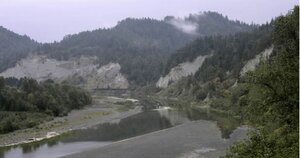Last tree-sitters come down from California redwoods

Spared from the saw: The Eel River flows past a grove of old-growth redwood trees near Scotia, Calif. Environmental activists and new owners of the forest have reached an agreement to spare the trees.
Photos by Rich Pedroncelli/AP
Scotia, Calif.
After more than 20 years of protests, the last two people living in the giant redwoods of northern California were climbing down for good, convinced by the new owners of the forest that the ancient trees would be spared from the saw.
Still, the tree sitters looked rather lost.
Having lived nearly 200 feet off the ground for 11 months, Nadia Berg — who calls herself Cedar — seemed unsure of her footing on the lush forest floor of Humboldt County’s Nanning Creek grove.
Cedar had made herself at home in a tree dubbed Grandma, a massive double redwood joined at the base, and had grown accustomed to the whistles and whispers and ways of the woods.
“Being here, for me, hasn’t been a sacrifice,” said the 22-year-old Alberta native, still in her harness after rappelling down Grandma last week for the final time. “I feel so honored that I could be here for the trees.”
Ms. Berg’s neighbor, Billy Stoetzer, a 22-year-old activist from the Missouri Ozarks, came down last week, too, after living for nearly a year in a hammocklike shelter in the branches of Spooner, a 300-foot mammoth at least 1,500 years old.
With that, the great timber wars of the North Coast came to an end.
It was a long, twilight struggle that redefined environmental activism and introduced the American public to a new type of civil disobedience — tree-sitting.
So quietly did the truce happen that almost no one involved can believe it. But the drawn-out, sometimes violent, battles between Pacific Lumber Co., the largest private owner of old-growth redwoods, and environmental activists who flocked here to save the trees, are history.
Pacific Lumber has new owners, a new name — Humboldt Redwood Co. — and a new pledge to protect old trees, some of which were around before Jesus was born.
The end began a few weeks ago, when Michael Jani, the president and chief forester of the new Humboldt Redwood Co., hiked into the woods to meet the tree-sitters.
“I went out, looked at the trees, looked at the stand of trees that were around them, and I explained to them that under our policy, we would not be cutting those trees,” said Mr. Jani, a 35-year veteran of logging companies.
Protecting old-growth trees was part of the plan that Humboldt Redwood, largely owned by Don and Doris Fisher of The Gap Inc., submitted to acquire Pacific Lumber in bankruptcy court.
Among other things, Humboldt Redwood promised to spare any redwood born prior to 1800 with a diameter of at least four feet. It also pledged to avoid clear-cutting, or cutting down trees in vast swaths, a practice that the timber giant aggressively practiced under its previous owner, Maxxam Inc.
Environmentalists are cautiously optimistic that the company will do as it promises. So for weeks, the tree-sitters at the Nanning Creek and Fern Gully groves have been clearing out their encampments, removing their platforms and figuring out what to do with the rest of their lives.
“At this point, I’d like to focus on growing a garden,” said an activist who goes by the nom de guerre Rudi Bega, as in “rutabaga.” The 28-year-old Idahoan is an 11-year veteran of the timber wars who helped recruit, train, and organize tree-sitters.
Since tree-sitting as a long-range protest began here in the late 1980s, hundreds of protesters have converged on this rugged corner of the state to take turns squatting in the redwoods, and hundreds of “bottom liners,” or support crew members, have helped them from the ground.
They have lugged in food, water and other supplies, emptied waste buckets, and provided company.
Tree-sits were just part of the fight that began almost as soon as Texas financier Charles Hurwitz, chairman of Maxxam Inc., acquired Pacific Lumber with junk bonds in 1986.
Blockades of logging trucks, sit-ins at company offices, lawsuits by environmental groups and rallies attended by tens of thousands of protesters were part of the mix.
Several battles made international headlines. They included the 1990 car bomb blast that nearly killed Earth First! Leaders Judi Bari and Darryl Cherney; the pepper spray swabbing of protesters’ eyes by Humboldt County deputies in 1997; the 1998 death of an activist, killed by a tree cut down by an enraged logger; the marathon two-year tree-sit by Julia “Butterfly” Hill that ended in 1999; and the buying of 10,000 acres of the Headwaters Forest from Pacific Lumber by the state and federal government in 1999.
The car bombing put the timber wars on the map. Cherney and Bari were driving in Oakland, recruiting volunteers for protests they dubbed Redwood Summer, when a bomb exploded under the front seat of their car.
Oakland police and the FBI accused them of transporting the bomb for use in an ecoterrorist attack.
Twelve years later, in 2002, the pair won $4.4 million in a lawsuit; a jury ruled that their civil rights had been violated and their names defamed by the local and federal authorities who arrested them.
“This has been a long-term campaign with a tremendous amount of high-water marks,” Mr. Cherney said of the timber wars. As for the end of the fight with Pacific Lumber, he said: “I have a healthy dose of skepticism. But it does feel like a great weight has been lifted from the shoulders of southern Humboldt County to have Maxxam gone.”
